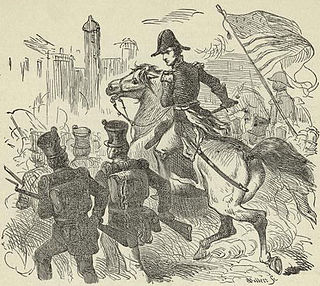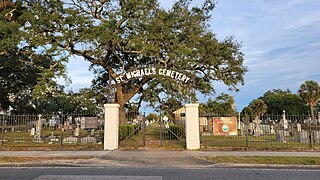
The Seminole Wars were a series of three military conflicts between the United States and the Seminoles that took place in Florida between about 1816 and 1858. The Seminoles are a Native American nation which coalesced in northern Florida during the early 1700s, when the territory was still a Spanish colonial possession. Tensions grew between the Seminoles and settlers in the newly independent United States in the early 1800s, mainly because enslaved people regularly fled from Georgia into Spanish Florida, prompting slaveowners to conduct slave raids across the border. A series of cross-border skirmishes escalated into the First Seminole War in 1817, when American General Andrew Jackson led an incursion into the territory over Spanish objections. Jackson's forces destroyed several Seminole and Black Seminole towns, as well as the briefly occupied Pensacola before withdrawing in 1818. The U.S. and Spain soon negotiated the transfer of the territory with the Adams-Onis Treaty of 1819.

Pensacola is the westernmost city in the Florida Panhandle. It is the county seat and only incorporated city of Escambia County, Florida, United States. At the 2020 census, the population was 54,312, up from 51,923 at the 2010 census. It is the principal city of the Pensacola—Ferry Pass—Brent, Florida Metropolitan Statistical Area, which had 509,905 residents in 2020.

West Florida was a region on the northern coast of the Gulf of Mexico that underwent several boundary and sovereignty changes during its history. As its name suggests, it was formed out of the western part of former Spanish Florida, along with lands taken from French Louisiana; Pensacola became West Florida's capital. The colony included about two thirds of what is now the Florida Panhandle, as well as parts of the modern U.S. states of Louisiana, Mississippi, and Alabama.

The Battle of Pensacola took place during the Creek War, part of the War of 1812, in which American forces fought against forces from the kingdoms of Britain and Spain who were aided by the Creek Indians and African-American slaves allied with the British. General Andrew Jackson led his infantry against British and Spanish forces controlling the city of Pensacola in Spanish Florida. Allied forces abandoned the city, and the remaining Spanish forces surrendered to Jackson.

The siege of Pensacola, fought from March 9 to May 10, 1781, was the culmination of Spain's conquest of West Florida during the Gulf Coast Campaign of the American Revolutionary War.

The Battle at The Village, also known as the Second Battle of Mobile, fought on January 7, 1781, was a failed British attempt to recapture a Spanish fortification at "The Village," during the American Revolutionary War. The attack was led by Waldecker Colonel Johann von Hanxleden who was killed in the attempt.

Spanish Florida was the first major European land-claim and attempted settlement-area in northern America during the European Age of Discovery. La Florida formed part of the Captaincy General of Cuba, the Viceroyalty of New Spain, and the Spanish Empire during Spanish colonization of the Americas. While its boundaries were never clearly or formally defined, the territory was initially much larger than the present-day state of Florida, extending over much of what is now the southeastern United States, including all of present-day Florida plus portions of Georgia, South Carolina, North Carolina, Alabama, Mississippi, and the Florida Parishes of Louisiana. Spain based its claim to this vast area on several wide-ranging expeditions mounted during the 16th century. A number of missions, settlements, and small forts existed in the 16th and to a lesser extent in the 17th century; they were eventually abandoned due to pressure from the expanding English and French colonial settlements, the collapse of the native populations, and the general difficulty in becoming agriculturally or economically self-sufficient. By the 18th century, Spain's control over La Florida did not extend much beyond a handful of forts near St. Augustine, St. Marks, and Pensacola, all within the boundaries of present-day Florida.

The Catholic Diocese of Pensacola–Tallahassee is a Latin Church diocese in the Florida Panhandle region of the United States. The patron saint of the diocese is St. Michael the Archangel.
Reuben Kemper was an American pioneer and filibuster.

Noriega is a surname of Spanish origin, and may refer to:
The history of Pensacola, Florida, begins long before the Spanish claimed founding of the modern city in 1698. The area around present-day Pensacola was inhabited by Native American peoples thousands of years before the historical era.

The Floridas was a region of the southeastern United States comprising the historical colonies of East Florida and West Florida. They were created when England obtained Florida in 1763, and found it so awkward in geography that she split it in two. The borders of East and West Florida varied. In 1783, when Spain acquired West Florida and re-acquired East Florida from Great Britain through the Peace of Paris (1783), the eastern British boundary of West Florida was the Apalachicola River, but Spain in 1785 moved it eastward to the Suwannee River. The purpose was to transfer the military post at San Marcos de Apalachee and the surrounding district from East Florida to West Florida. From 1810 to 1813, the United States extended piecemeal control over the part of West Florida that comprised the modern-day Gulf coasts of Alabama and Mississippi and the Florida Parishes of Louisiana. After the ratification of the Adams-Onis Treaty in 1821 the United States combined East Florida and what had been the remaining Spanish-controlled rump of West Florida into the territory that comprised modern-day Florida.

Arturo O'Neill de Tyrone y O'Kelly was an Irish-born Spanish colonel who served the Spanish crown as governor of several places in New Spain. He came from a lineage that occupied prominent European positions and titles, since at least the 12th century.

Old St. Ferdinand Shrine and Historic Site is located at no. 1 rue St. Francois, Florissant, Missouri, and is owned, preserved, maintained, and protected by the non-profit organization, Friends of Old St. Ferdinand, Inc. The Shrine and Historic Site consists of four historic buildings on their original locations: the 1819 convent, 1821 church, 1840 rectory, and 1888 schoolhouse.

Spanish West Florida was a province of the Spanish Empire from 1783 until 1821, when both it and East Florida were ceded to the United States.
Enrique White was an Irish-born Spanish soldier who served as Governor of West Florida and of East Florida.
Carlos Howard was an Irish-born military officer who served as Governor of West Florida, between 1792 and 1793. Prior to that appointment, he served as secretary and general administrative assistant to the East Florida Governor Vicente Manuel de Céspedes y Velasco, in St. Augustine.
Vicente Sebastian Pintado y Brito was a Spanish cartographer, engineer, military officer and land surveyor of Spanish Louisiana and Spanish West Florida. He is known for conducting surveys of lands for settlers who had requested grants in Louisiana and Florida, as well as the so-called "Pintado plan", a street map of Pensacola drawn in 1812 which included the position and size of the solares designated for construction of the city's church and other public buildings. He lived for more than 35 years in America and left a large corpus of work consisting of maps, plats, letters and documents vital to an understanding of the complicated sale of lands in Florida and Louisiana during the period. In 1974, the Library of Congress in Washington, D.C. obtained a donation of the Pintado Collection, a collection of about 1,500 documents now stored in its Division of Manuscripts.

St. Michael's Cemetery is a cemetery in Pensacola, Florida. The land around the current location of the cemetery has been used as a burial ground beginning in the mid to late 18th century, with the earliest above-ground markers associated with Pensacola's Second Spanish Period.













